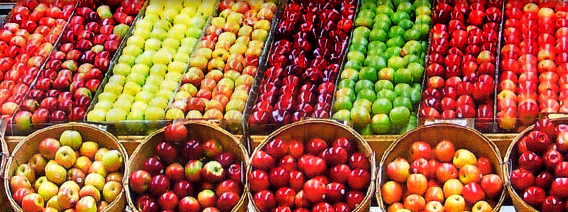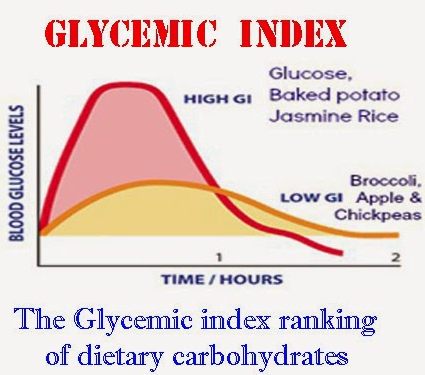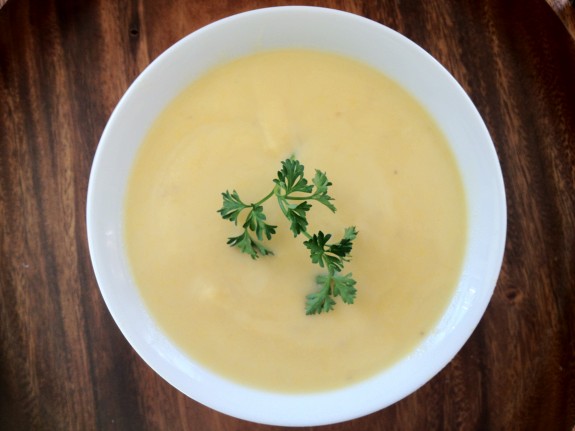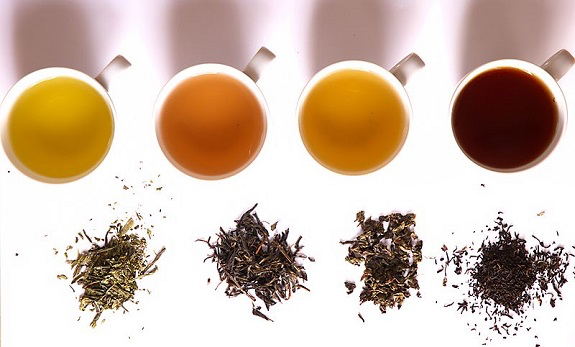Prenatal Fruit Intake Boosts Cognition in Infants + Springtime Strawberry Salad
Some of the most interesting nutrition studies I’ve read have to do with the prenatal diet and subsequent effects in children. The subject is vast and the outcomes amazing. Did you know that when pregnant moms drink high amounts of carrot juice during pregnancy, their toddlers are more likely to choose carrots over other vegetables? Or, that the more varied a pregnant mom’s diet, the more her child will choose and enjoy a wider variety of foods? All proven by science!
So it’s no surprise that a new study published in The Lancet found that prenatal fruit consumption is correlated with superior cognition in the mothers’ one-year-old infants – though there was no effect if fruit was only fed to the child during the year after birth. So, what may explain this finding?
Evolution may explain, in part, this advantage of fruit-eating. During the neolithic (stone age) period about 12,000 years ago and for thousands of years thereafter, we subsisted mainly on fruits and vegetables; which comprised about 65% of our calories, according to S. Boyd Eaton, from the department of Anthropology at Emory University in an interview and in his essay, “Evolution, Diet and Health.” That may mean that brain development is still dependent on the same high level of vitamins, minerals, antioxidants, and other positive nutrients that kind of diet would provide. And this could help explain why, even today, a high fruit diet is correlated with so many positive health benefits: reduced incidence of diabetes, heart disease, cancer, arthritis, eye disease, and other conditions. Keep in mind, too, that the health-giving Mediterranean Diet had 12 to 13 servings of fruits and vegetables daily, and it’s known as one of the healthiest diets on the planet.
Fruit is so easy to eat every day, and the local fruit season is just beginning to get exciting. I was most fortunate to receive one of the most delicious dishes I’ve ever eaten this weekend when my friend and neighbor, Mike Gardner, brought me his salad:
Only Certain Fruits & Vegetables May Cause Weight Loss
- At March 01, 2016
- By Katherine
- In Articles, News
 3
3
For the first time, scientists have discovered certain fruits and vegetables – and not others – are associated with preventing weight gain over the course of many years regardless of calories, according to a recent Harvard study published in the British Medical Journal. These fruits and vegetables contain a class of phytonutrients called flavonoids, a plant compound with anti-inflammatory and anti-oxidant properties, among other benefits.
“The particular fruits and vegetables associated with less weight gain are rich sources of several flavonoid subclasses, particularly flavonols, anthocyanins, and flavones. Animal models and short term human studies provide evidence for underlying mechanisms that relate flavonoids to weight: several flavonoid subclasses have been shown to decrease calorie intake, increase blood sugar uptake in muscle in humans, and decrease blood sugar uptake in fat tissue in test tube studies. Other studies, predominantly focusing on green tea, a rich source of the flavan-3-ol subclass of flavonoids, provide evidence to suggest that flavonoids may decrease fat absorption, increase energy expenditure, and inhibit body fat synthesis,” according to the study.
In the study, anthocyaninins, the blue pigment in many fruits and vegetables, were mainly found in blueberries and strawberries, among others. Flavan-3-ols were mainly from tea, apples, pears, and peppers.
So, while it’s important for your health and weight management to eat at least 5 cups of fruits and vegetables daily, you may want to consider adding these very specific fruits and vegetables to your routine. “An Apple A Day…”
Can Daily Grape Juice Reduce Stress?
- At February 14, 2016
- By Katherine
- In Articles, News
 0
0
Can anything relieve stress in today’s high stress world? This is an important question to answer as studies show high stress can reduce your ability to think straight and increase your blood pressure; conditions which could be dangerous in certain complex, every-day tasks, such as driving. A University of Leeds study of one of the most harried population groups – working moms – found just 12 ounces of concord grape juice daily improved their ability to think by increasing their spatial memory in a driving performance test. And the effect lasted over time.
Concord grapes are high in a class of phytochemicals (beneficial plant chemicals) called polyphenols, antioxidants which are concentrated in many fruits, some vegetables and in wine, tea and cocoa. They protect against heart disease by reducing blood clot formation. They also prevent cellular and organ damage caused by oxygen radicals, molecules which are believed to be a primary cause of many diseases including cancer and cardiovascular disease.
Certain polyphenols, such as anthocyanins, which give grapes and blueberries their purple pigment, have been found to reverse both physical and mental deficits in aging rats. Preliminary studies in humans, including this study, are showing similar promising results.
Learn more about the health benefits of concord grapes, concord grape juice and wine…
Kale! Kale! Everywhere!
Kale and Spinach Gratin with Garlic, Rosemary, and Thyme
(excerpted from Diet Simple Farm to Table Recipes)
Serves 6
1 pound Kale, cleaned and stems removed
2 pounds Spinach, cleaned and stems removed
1 Tablespoon Olive or Canola Oil
1 Large Garlic Clove, minced
2 teaspoons fresh Rosemary, chopped (or 1 tsp dry)
1 teaspoon fresh Thyme leaves, chopped (or ½ tsp dry)
1 recipe Olive Oil Bechamel Sauce (see recipe)
Salt and Freshly Ground Pepper to taste
¼ Cup Parmesan or Gruyere Cheese, freshly grated
Preheat oven to 400 degrees F. Wash the Kale and Spinach and remove the tough stems. Chop roughly. Heat the oil in a large iron skillet over medium-low heat. Add the garlic and cook until it just begins to color. Add the greens, the rosemary, and thyme to the pan, and let cook a couple of more minutes while stirring until the greens are wilted.
Stir the Bechamel sauce into the greens. Add salt and pepper. Pour into an oiled 2-quart soufflé or heat resistant glass dish and sprinkle the cheese on top. Bake at 400 degrees F for 20 to 30 minutes, or until the top is just beginning to brown.
Olive Oil Bechamel Sauce
This is a classic French white sauce, but using healthy olive oil instead of butter.
Makes 2.5 cups
3 Cups 1% Milk
2 Tablespoons Olive Oil
2 Tablespoons Flour
Salt and Ground Pepper to taste
Pinch of grated nutmeg (optional)
Simmer the milk in a saucepan on medium-low heat. Meanwhile, heat the olive oil in a heavy skillet. Add a bit of flour, and when it sizzles, add the rest. Stir constantly with a wooden spoon or whisk over medium heat. Do not brown. Whisk in the hot milk. Return the mixture to the heat, stirring until the sauce thickens. Reduce to low making sure it does not burn. Add salt, pepper and nutmeg to taste.
Deep Green Leafy Vegetables have the highest antioxidant content of all vegetables. High in fiber, they are rich in minerals, B-vitamins, beta-carotene, and lutein, a compound which may help reduce the risk of age-related macular degeneration (the leading cause of preventable blindness) and other eye diseases such as cataracts. Absorption of carotenoids, such as lutein, in your body is increased by cooking and by the presence of fat (so cook in a little healthy olive or canola oil!).
New Study: The Glycemic Index of Foods Varies From Person to Person
- At December 27, 2015
- By Katherine
- In Articles, News
 0
0
The “Glycemic Index” may not be so cut-and-dry. What’s healthy for other people may not be healthy for you!
We all have friends who, no matter what they eat, stay skinny. But the opposite is more common: most of us are incredibly frustrated because, it seems, no matter how hard we try, we just cannot lose weight. Now we may understand at least one reason why.
A study published in the journal, Cell, in November, analyzed people’s glycemic (blood glucose) response, or blood sugar’s rise and fall after a meal. Controlling blood sugar is important for preventing and controlling diabetes, maintaining a healthy weight, and general all-around health. What you eat affects your blood sugar, insulin, and health levels, so a healthy diet containing mostly low glycemic index foods has been thought to be one way to control your health.
Some of the study’s results were typical and expected; glucose levels correlated with weight and age. The more overweight or older we are, the higher our blood sugar rises after meals – that is, we become more diabetic-like.
But the scientists also found important differences between individuals. First, and this was predictable: if the same person ate the same meal at different times, their blood sugar level responses remained relatively the same. But – and this was the unpredictable result of the study – different people eating the same meal at the same time produced highly variable results.
Researchers believe the differences might be explained by the quality of the gut microbiome, the understanding of which may revolutionize nutrition and health. It turns out that the bacterial organisms in the digestive tract — about 100 million of them (10 times the number of human cells), collectively called the microbiome — are akin to a fully functioning organ, and can have a positive or negative effect on human health. For instance, a healthy microbiome improves insulin sensitivity – reducing your chances of getting diabetes – and enhances your ability to lose body fat.
This – the quality of your microbiome, for instance – calls into question things like the glycemic index (GI), which assigns a food’s value based on peoples’ average glycemic response to a food. That’s because, if each person’s blood sugar responds differently at different times with different foods, then the GI index would be incorrect for people with different-than-average blood sugar responses, even for foods generally believed to be healthy.
There is some good news, though! The researchers used the data to create an algorithm that predicted the glycemic response of the participants. When they used this data to tailor diets for people, they saw improved blood sugar responses. These findings could be used to develop personalized and individual diets that don’t rely on averages. This just may crack the case for those having difficulty getting fit.
This is why I find it so important to PERSONALIZE your diet. One size doesn’t fit all!
Supplement Manufacturers Sued and Arrested for False Claims
- At December 27, 2015
- By Katherine
- In Articles, News
 0
0

The United States Department of Justice brings criminal charges against popular supplement manufacturers
There are a LOT of dietary supplements on the market. They all make lots of claims about what they can do for your body and health – many in particular tend to trumpet their ingredients, especially if they’re “all natural.”
Well, the Department of Justice thinks we can’t trust what the supplements tell us. DOJ brought civil and criminal actions against 117 – yes, you read that correctly, 117 – individuals and entities. Of those, 89 have so far been the subject of cases.
Some are accused of mislabeling because the product has ingredients not listed on the label. Others are charged with making claims about what the supplement can do without adequate supporting scientific evidence. An Assistant Attorney with DOJ said they brought these actions “so consumers know the serious health risks of untested products.”
One particularly bad case is USPlabs LLC, which made both workout and weight loss supplements. DOJ alleges that USPlabs used synthetic stimulants instead of natural plant extracts that they advertised. Further, USPlabs is charged with knowing that one supplement, OxyElite Pro, might cause liver toxicity and secretly selling OxyElite despite telling the FDA it would stop. Because of this, 6 employees have been arrested, and company assets have been seized.
You can read more information about UPSlabs and other companies in their press release. But use this as a warning, and be careful what supplements you buy! You should always do your research on supplements before you add them to your routine – talk to a health professional if you can! At the very least, though, be glad that someone is working toward your best interest.
Just Say No! Handling Holiday Food Pushers & Proselytizers
- At December 20, 2015
- By Katherine
- In Articles, News
 0
0
One of my clients, who came to me to lose about thirty pounds, had a real problem. He loves to eat and he loves to please people. In fact, he said pleasing people is the main reason he overeats. This tendency becomes especially troublesome over the holidays when friends, family and colleagues invite him for meals. My kind client literally cannot say no to anything.
As a result, he says holidays are a time of joy, but also frustration, because his need to be polite is in stark conflict with his goal of trimming down. Many of us can appreciate his dilemma. Holiday delicacies can be difficult to navigate, especially if you’re trying to avoid gaining a pound per week from Thanksgiving to the New Year. And that can bring out the best and the worst in people, hosts and guests alike.
We all know hosts who aren’t satisfied until they convince us, beg us, to eat more, more, more. Their misguided entreaties are hard to resist, if only because we want to be polite.
To be fair, food pushers aren’t bad people at heart. Your mom, your spouse, your friends – they just want to please you. They’re people who think they have your best interests at heart and know more about what and how much food (and drink) you should be consuming than you do. It seems these people aren’t happy until they’ve stuffed you as if you’d just ended a hunger strike.
My clients and I have tried various tactics through the years, most of them utter failures. For instance, I’ve found the worst thing you can say to a food pusher is, “No thanks, I’m on a diet”… or “Thanks, I’m watching it.”
You might as well say, “Talk me into it!” Your excuse is giving the food pusher a double signal – that you really want it, but have to refuse. It’s also insulting, as though you’re saying the food isn’t good enough for your refined tastes. And, finally, it may bring up guilty feelings in the pusher, that they should be “watching it” too. All of which challenge the pusher to seduce you.
No excuse seemed to work as I tried to fight back the food pushers’ advances, including explaining that I wasn’t hungry. I even went through a phase of telling people I’m allergic to this or that. Sadly, that didn’t work, either.
I didn’t start sensing positive results from my refusals until I learned the most basic rule of all: never give excuses. And I’m delighted to say that one of the foremost authorities on etiquette told me that this approach is both appropriate and wise.
“The best answer is a simple but firm ‘No thank you,’” declared Judith Martin, syndicated columnist who writes as Miss Manners. “Once you give an excuse, you open yourself to argument.”
Miss Manners also offered clear advice in her column to food pushers, and their “endless patter of coercion – ‘Oh, come on, one won’t hurt you, I made this especially for you, it doesn’t have any calories, you’re too thin anyway, it’s good for you, you’re not going to make me eat leftovers tomorrow.’ Miss Manners asks them to cut it out.”
“To offer and provide food is lovely, but to badger people into eating it isn’t pleasant,” Martin told me. “Politeness consists of offering food and drink without cajoling or embarrassing people into taking it.”
But families may present a more complex and challenging case. I somehow doubt my family would have heeded Miss Manners’ advice when I was growing up. I was so hounded to eat more, more, more! It seemed almost every dinner became a power struggle, even though I kept asserting that I was simply not hungry. The holidays were the worst. With all that food around, what I was eating seemed impossibly meager to my family.
Scientists have now concluded that pushing food on children is a big mistake. It ruins their ability to self-regulate food intake based on their natural hunger signals. Infants know naturally when to eat and when to stop. But, by around age four or five, if children are pushed or rewarded to eat more than they naturally want, they’ll start overeating regularly.
When I became an adult, I again tried to assert myself, but to no avail. During visits to my grandparents in Sweden, for instance, every day I felt overstuffed from too many fattening (and, yes, delicious) Swedish meatballs, cheeses and cakes. Inevitably with each visit, I came home several pounds heavier. While “no thank you” was fine for hosts, I had to use a different tactic with my family. They just didn’t take “no” for an answer!
I decided the solution was to take a more positive approach. There was no changing the fact that my family wanted to please me with food. So I decided I’d drop subtle hints and compliments to guide them into serving me food that wasn’t going to make me look and feel like a Swedish meatball.
This technique of continued positive reinforcement took several years (in psychology, it’s called “shaping”), but it eventually worked beautifully. When they served seafood, salads, fruits – food I wanted more of – I complimented lavishly. “Sweden has the best fish in the world!” “I just love your salads!” (which was all true, by the way). You get the idea. Over time, whenever I’d visit, they’d lavish me with what they learned that I especially loved: seafood, salads and fruits. (Yes, I also loved the fattening stuff, but that was easily obtained and I wanted to limit my indulgences without announcing it).
The same technique can work with your coworkers, friends and family, and it doesn’t have to take years. At Thanksgiving or over the holidays, instead of focusing on what you don’t want or can’t have, and using turn-off words such as “healthy” or “diet,” simply compliment your hosts and stay positive so they’ll know what pleases you. Instead of, “Oh, I can’t have that,” when offered the 1600 calorie prime rib, say: “I’m really in the mood for a crunchy, delicious salad!” Instead of saying: “fried calamari is so fattening,” say: “Steamed shrimp sounds yummy!” Instead of: “I can’t have dessert, I’m watching it,” say: “The meal was so satisfying, I can’t have another bite!” or “I’m really craving fresh raspberries!”
My client was thrilled when he tried this tactic with his family and friends, and has been successfully losing weight ever since. He was surprised at how a simple compliment could stop food pushers in their tracks and is looking forward to using the techniques over the holidays.
Even Miss Manners agrees that using simple compliments is okay as long as you don’t go into too much detail. In the end, no food pusher can resist a happy guest.
Of course, as a guest, you have obligations too. While issuing compliments and saying “no thank you” is perfectly acceptable, forcing your likes, dislikes and opinions about food on the host or other guests can be downright unappetizing.
Today, it seems almost impossible to escape people on this diet or that, freely espousing their strident views and suspect theories. My clients regularly complain that their guests expect them to cater to their particular dietary requirements – no carbohydrates, no fat, no white flour, no sugar, ad nauseum. While it may be fine to be following a diet, expecting the host to be a short order cook is unfair. And discussing dietary views at the table is a no-no. It can make people feel uncomfortable, guilty, and even angry. Today, food is political. It’s also very personal. Everyone has their own strongly held views.
“This attitude that other people haven’t seen the light and you have to make them see the light makes the experience of eating unpleasant,” says Martin. “Cooking has improved enormously over the decades, but the experience of eating has gone downhill because people are so self righteous and willing to boss other people around.”
What I’ve come to realize is that when we visit family or friends for holiday parties or meals, there is a joint obligation at work, a sort of unspoken agreement. We should visit friends and loved ones with a generous spirit, grateful for the meal provided. We’re there to have fun and enjoy. On the other hand, hosts have an obligation not to force their hospitality on guests, compelling them to eat more than they wish. It’s not polite, is counter-productive and feels uncomfortable to notice or comment on what or how much a person is eating.
Eat Soup and Lose Weight!
Soup. Nothing warms the body or soul like it. And studies show, eating it helps you lose weight. My clients who make batches of soup this time of year do – as do I. That’s great news because during this time of year, we all crave hearty, satisfying dishes, which are almost always fattening – with most soup being the exception…
Classic studies have found that as long as the volume of the food is high, even if the volume is just water with no added calories, people can feel full with fewer calories. In one study, researchers varied the amount of water in a food eaten as a first course to study this effect. Subjects were fed one of three contitions: either chicken rice casserole, chicken rice casserole served with a glass of water or chicken rice soup. The subjects who ate the soup consumed 26 percent fewer calories at the main course compared to the other conditions.
In another study, the researchers served salads of various sizes and calorie levels before a main course to determine the effect on the calorie intake of the whole meal. They found that people consumed the fewest overall calories—100 calories fewer—when they were served the largest, lowest-calorie salad before a meal. Vegetables are foods that have a naturally high water content. The higher a food’s water content, the higher its volume, but the lower its calorie density.
Researchers surmise that a large food volume caused by water or air, even without added calories, influences satiety in a variety of ways. When the water is incorporated into the food (as opposed to just a glass of water), it causes stomach stretching and slows stomach emptying, stimulating the nerves and hormones that signal feelings of fullness. Also, visually seeing a large volume of food can increase your ability to feel satisfied by it. Finally, the larger a meal and the longer a meal goes on, studies show, your satisfaction declines and you lose interest in completing it. Water is the component in food which has the largest influence on how much you eat. These studies show eating a high-water-content, low-calorie first course enhances satiety and reduces calorie intake at the next course. This effect persists over time.
One of my favorites found in my new book: “Diet Simple Farm to Table Recipes: 50 New Reasons to Cook in Season!” is featured in the photo above, Cauliflower Vichyssoise…
New Studies on Cocoa: Reduces Wrinkles and Protects Against Alzheimer’s Disease
- At November 29, 2015
- By Katherine
- In Articles, News
 0
0
For most people, chocolate is a delicious treat to enjoy in moderation. Some new scientific work, though, may give you an excuse to treat yourself more often.
The first, a study published in the Journal of Nutrition, examined the effects of cocoa on the moderately sun damaged skin of women aged 43 to 86. The participants drank flavanol-enhanced cocoa drinks, containing 320 mg flavanols** daily, over 24 weeks. It’s been established in previous studies that flavanols in cocoa – and other foods – help maintain a healthy vascular system, relax blood vessels (lowering blood pressure), reduce blood clotting – an aspirin-like affect –reduce oxidative damage, and improve blood flow. This new study found that women who drank the flavanol – fortified cocoa drink (containing the equivalent of about 4 tablespoons of cocoa daily**) experienced reduced wrinkles and increased skin elasticity, thereby reducing the effects of sun damage and aging – probably due mostly to their antioxidant and anti-inflammatory properties.
Cocoa flavanols may impact brain aging, too, according to a recent Journal of Alzheimer’s Disease review. Previous research has shown that flavanols contribute to healthy brain aging and cognitive decline prevention by improving blood flow to the brain and reducing the oxidative and inflammatory damage which occurs with aging. But cocoa harvesting and production produces highly variable levels of flavanols in cocoa products. So scientists are looking for more consistent methods for developing cocoa flavanol formulas containing higher levels of flavanols. “The ultimate goal of this review is to provide recommendations for future developments of cocoa extracts as a therapeutic agent in AD [Alzheimer’s Disease].”
These results could mean big things down the line for brain and skin health! Meanwhile, keep in mind that flavanols are also found in tea, wine and many fruits and vegetables. Also, nutrition studies tend to use concentrated forms of nutrients so the effects are more measurable and significant. Conclusion: eat a plant-based diet!
Read more extensive information on cocoa and its health benefits…
Katherine’s Chocolate for Health Tips:
If you’re eating chocolate for health benefits, you’ll need to be very discriminating in your selections.
You’ll get more flavanols, and therefore health benefits, with less processing. The first choice is cocoa, which isn’t Dutch processed – as when cocoa is “Dutch processed with alkali” the flavanols are reduced. Look for chocolate which has the highest percentage of cocoa as possible and to save calories, look for chocolate with lower fat and sugar levels. In general, cocoa is your best first choice. Second choice is a semisweet or bittersweet chocolate with a high cocoa percentage. Some chocolates go as high as 85% cocoa, but legally can be as low as 35%. I recommend no more than an ounce a day, which may be about 110 – 150 calories, depending on the chocolate. Any more than that and you’re probably going to take in too many calories for weight control
**The numbers:
Type of Chocolate Mg Flavonols Calories
1.3 oz Dark Chocolate Bars, Average*: 82 mg 187
1.3 oz Milk Chocolate Bars, Average*: 42 mg 198
1 TBSP Unsweetened Cocoa Powder, Average*: 75 mg 12
*USDA’s Nutrient Data Laboratory
Tea Has Amazing Health Benefits – Green or Black Tea
- At November 20, 2015
- By Katherine
- In Articles, News
 0
0
Need an excuse to break for afternoon tea at work? A new study found green or black tea, in a very concentrated form, can improve your overall health in many different ways.
As I wrote in my Washington Post article, tea has long been known for its antioxidant and anti-inflammatory properties. So researches decided to extract one of the most active compounds in tea to see what would happen. The extract, called “AssuriTEA,” was given to subjects in different doses. They found all doses had benefits, but most of the benefits were experienced in the subjects with the largest dose. After taking the extract for 28 days, the subjects showed improved antioxidant levels (which protects you from almost all diseases), lower blood glucose levels, and increased energy. They also found lower systolic blood pressure at both dosages and lower diastolic blood pressure at the higher dosage.
Even though we don’t have access to this extract; no matter; I recommend using “whole” tea leaves anyway: The whole food is always better! Studies use concentrated forms of foods so they can more easily measure results. This study, published recently in the journal “Functional Foods in Health and Disease,” confirms the health benefits of tea are impressive – I know what I’m doing at 3 o’clock today! You?



















